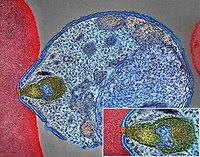
Photo from wikipedia
Abstract This study developed an insect-repellent film incorporated with star anise essential oil (SAEO). The insect-repellent emulsion coating (IEC) was applied to a base layer of polyethylene terephthalate. To control… Click to show full abstract
Abstract This study developed an insect-repellent film incorporated with star anise essential oil (SAEO). The insect-repellent emulsion coating (IEC) was applied to a base layer of polyethylene terephthalate. To control the rate of SAEO released from the IEC, three types of laminate film with different gas transmission rates were used, including low-density polyethylene film, polypropylene film of 20-μm thickness, and polypropylene film of 30-μm thickness (PP30). When prepared at a laboratory-scale, the PP30 proved the most efficacious in providing long-lasting insect-repellent activity and the sensory attributes of the PP30 were not significantly different (p > 0.05) from those of the control film (i.e., without the IEC layer). Therefore, the PP30 selected for further analysis. The active film was then manufactured at a pilot-scale using a rotogravure printing press, and its mechanical and optical properties were evaluated. Although the active film had a similar appearance with the control film to the naked eye, the active film had relatively lower tensile strength and elongation at break values, and it was less transparent with a more reddish color. Finally, the active film was applied as bread packaging, and the results suggested that as a food packaging material, the film showed excellent insect-repellent activity. Therefore, the developed active film in the pilot-scale has applicability to a real food system.
Journal Title: Food Packaging and Shelf Life
Year Published: 2020
Link to full text (if available)
Share on Social Media: Sign Up to like & get
recommendations!